

This is the time of the year when fruit maturity (ripening) sets off on an exponential curve!
From the first Discovery it is only a matter of time before a succession of varieties come on line!
Below: Rosette Discovery grown by AC Goatham
Visit Kent On-Line to view AC Goatham & Son start to the new season.
In my garden, Red Devil, Red Windsor & Bladon Pippin are at various stages of maturity.
Below: Red Devil with some severe Sun scorch - Red Windsor already well coloured and Bladon Pipin just beginning to develop red colour
The importance of picking dates cannot be underestimated; to store apples & pears 'long term' and by long term we are looking at potential marketing of some fruit in May/June next year. To achieve this, the fruit MUST be harvested in the correct picking window.
Based on experience and the seasonal factors, we can expect Cox picking to start in the second week of September, with Gala starting in the third week. Braeburn will probably start in the second week of October.
Over the past few days The English Apple Man has been consulting industry friends who are busy carrying out maturity testing on our main apple and pear varieties.
This is a vital testing procedure determining when the likes of: Cox, Gala, Braeburn, (Dessert) Bramley (Culinary) and Conference Pears should be harvested for long term storage.
I am grateful to Nigel Jenner for giving me access to his maturity data.
Maturity testing 22nd August 2019
Maturity assessments have been carried out on a wide range of sites in Kent and Wisbech this week and our findings are as follows:-
Bramley
Bramley picking for long term storage should begin next week (w/c 26th August). Most sites have a huge range in size this season due to a retracted blossom period, so ensure you know the 'marketable' sizes before picking gets underway.
Generally calcium and phosphorous levels are similar to the long term averages, which bodes well for storage, but in orchards with a lighter crop and larger fruit, calcium levels are low.
In orchards with calcium levels less than the recommended 4.5mg/100g, picking should be delayed, as we know that early harvesting greatly exacerbates the chances of bitter pit developing in store and this will also give you a chance to apply another application of calcium.
Below: Bramley Sun Scorch
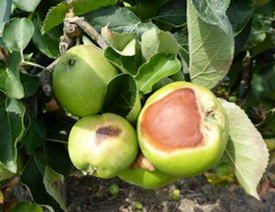 Sun scorch is a significant problem on some sites and if this fruit is picked, this will result in high levels of penicillium and brown rot occurring in store. Nectria eye rot could also be a feature this season due to a couple of wet days during flowering. Hopefully by now pre-harvest fungicides have been applied to help combat these potential issues.
Sun scorch is a significant problem on some sites and if this fruit is picked, this will result in high levels of penicillium and brown rot occurring in store. Nectria eye rot could also be a feature this season due to a couple of wet days during flowering. Hopefully by now pre-harvest fungicides have been applied to help combat these potential issues.
Strangely, although high levels of water core are being seen in some dessert samples, the levels in Bramley seem very low at present.
The risk of superficial scald developing on Bramley this year is likely to be low due to coolish night time temperatures in August (so far). This will be confirmed once we have all the temperature data from August to run the prediction model.
Conference
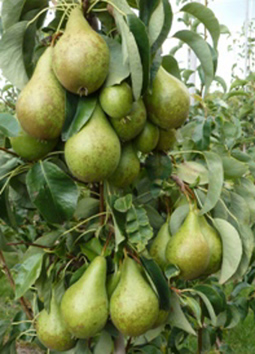 Maturity measurements carried out on a range of Conference sites this week can be summarised as follows:-
Maturity measurements carried out on a range of Conference sites this week can be summarised as follows:-
Picking targets: Streif Index.> 0.7 - Firmness (kg) > 5.5 - Starch (%) > 50 - Brix (%)>11.0
West Kent: Streif 3.1 - Firmness 7.9kg - Starch 79.6% - Brix 11.4%
East Kent: Streif 3.3 - Firmness 8.1kg - Starch 79.2% - Brix 12%
Wisbech: Streif 2.7 - Firmness 8.5kg - Starch 79.3% - Brix 11%
The English Apple Man Comments: Pears are best determined by using the Streif Index.
The Streif Index is comprised of three maturity measurements - (firmness, percentage soluble solids concen-
tration, and starch conversion)
Although Conference for long term storage could be harvested towards the end of next week on some sites, the optimum week for harvesting for long term storage on the majority of sites is predicted to be sometime in w/c 2nd September.
Size is likely to increase rapidly in the last week or so before harvest and with a warm weekend forecast, brix levels, which are currently lower than anticipated due to the rainfall experienced last week should improve noticeably. It is important to recognise that fruit is harvesting very easily for the time of year, so it will need very careful monitoring over the next week or so.
Cox
 Maturity measurements carried out on a range of Cox sites this week can be summarized as follows:
Maturity measurements carried out on a range of Cox sites this week can be summarized as follows:
West Kent: Streif: 5.3 - Firmness 9.7kg - Starch 95.4% - Brix 8.9%
East Kent: Streif 4.3 - Firmness 9.9kg - Starch 97% - Brix 10.8%
Picking Targets Streif N/A Firmness > 8.6kg - Starch > 70% - Brix > 11.0%
Although we can see some movement in starch on all Cox sites, it really needs a further week of testing to confirm optimum harvest dates for long term storage.
Firmness in both East and West Kent is below that recorded at the same date last year and brix levels are also lower at the moment. However, as with the pears, this is likely to be due to the rainfall received a week or so ago and we would expect the firmness to stabilise and brix levels improve after the warm weather which is forecast for this weekend.
On the data we have, it looks likely that Cox for long term storage will require harvesting somewhere around 5th- 6th September, but we will be able to confirm this next week.
Red colour on Cox (and on other varieties too) is progressing well following the colder nights we have been experiencing, although calcium levels are lower than the long term average. With this in mind, it may well be worth applying a further calcium spray to any Cox orchards you are intending to store for more than a few weeks.
Other varieties
Robijn - sites where cerone has been used are harvesting now.
Below: Early Windsor
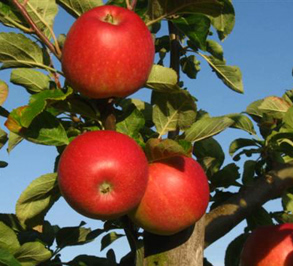 Early/Red Windsor - Firmness is currently 0.5 - 1.0kg lower than at the same stage last year and fruit is starting to colour up nicely.
Early/Red Windsor - Firmness is currently 0.5 - 1.0kg lower than at the same stage last year and fruit is starting to colour up nicely.
However, on most sites there are too many apples where the starch is yet to break (100%) and if these are harvested, they will break down in store and never ripen properly. If you think you should be starting to harvest now, providing the starch has broken on all the fruits, it is fine to start, but from all the samples we have analysed this week, the middle/end of next week will be the earliest this variety could be harvested to achieve the right eating quality out of store.
Storage samples
In order to optimise our store monitoring service and ensure the correct stores are being marketed at the correct time, it is critical that enough samples are provided to carry out proper assessments of your fruit in store.
Any orchards with 30 bins or more should have samples of 20 apples taken, which are an accurate representation of the fruit in the store. Remember that this is very often the only means we have of assessing the size, colour and quality profiles of your fruit and preliminary decisions regarding your fruit will be made from samples we assess on farm.
Please also ensure your samples are clearly labelled with farm name, orchard name, store name and picking date (particularly important as later in the year stores with fruit of the same quality are marketed according to picking date).
It is also critical that enough samples are provided. This year, it will be necessary to provide the following numbers of samples for fruit going into store:- Air stored fruit (all varieties) 5 samples.
Cox and Pears 8 samples - Bramley, Gala, Braeburn, Magic Star 12 samples - (plus any other variety being stored long term)
Maturity testing help??
"For many years we have operated a maturity testing service where we can accurately assess the maturity of your orchards on-farm and give you accurate advice based on your own individual orchards. If this is of interest to you or indeed you would like to chat over any of the above, please call me on 07870155571
Nigel Jenner - Chief Technical Officer - Avalon Produce Limited
---------------------------------------------------------------------------------------------------------------------------------
It is always educational to see what's going on in other parts of the World.
From New Zealand
New policies and standards could protect the most fertile and versatile land as soon as next year.
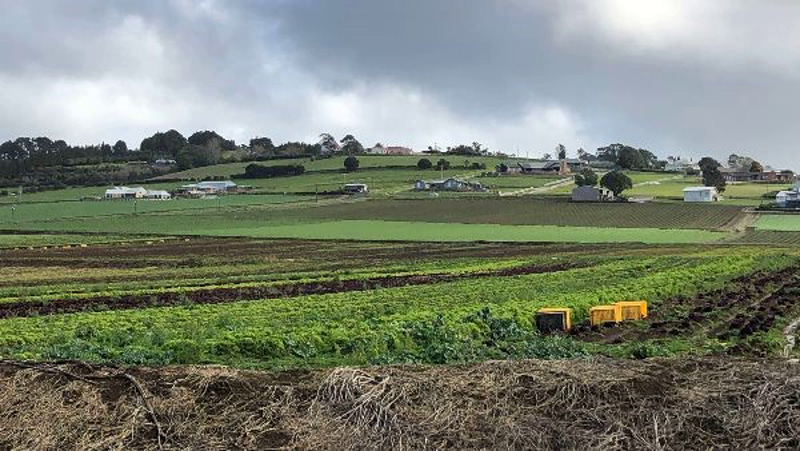
HortNZ has welcomed the move, saying 'once you build houses on our best soils, you cannot get them back. However, with good planning and buffer zones, houses and horticulture can co-exist.'
Agriculture Minister Damien O'Connor and Environment Minister David Parker have put out proposals to value high-quality soils as a resource of national significance.
"The threat to elite soils in this country has been very real," O'Connor said.
"We've been losing soils for the past 20 years at an alarming rate.
"You don't have to be a rocket scientist to visit Pukekohe and see what is happening."
The Government has released a draft National Policy Statement for Highly Productive Land that proposes a nationwide approach to protecting NZ's most productive land for future generations.
The statement was mooted by Parker last year as a result of concern over the amount of quality soils lost to urban development in the past generation.
It is intended to target the high-value classes 1 and 2 soils that account for 5% of NZ's soil profile but almost 85% of high-value crop production.
"One of the greatest challenges facing the world right now is the need to feed a growing population.
"We have a well-earned reputation for producing some of the best food in the world," O'Connor said.
"Continuing to grow food in the volumes and quality we have come to expect depends on the availability of land and the quality of the soil.
"Once productive land is built on we can't use it for food production, which is why we need to act now."
About 14% of NZ's land is categorised as highly productive.
But between 2002 and 2016 New Zealand has been losing more than 100,000 hectares a year of growing land to urban development or lifestyle blocks, which have been growing at a rate of 5800 a year.
Auckland's growth plays a significant part.
A report by Auckland City Council planner Ryan Bradley said about 66% of the city's future urban zoned land is on elite or prime soils, covering 10,095ha. The main areas affected are at Whenuapai, Kumeu-Huapai, Drury-Opaheke, Takanini and Pukekohe/Paerata.
Ministry for the Environment and Statistics NZ research showed towns and cities increased in size 10% between 1996 and 2012 and while agricultural land decreased 7% between 2002 and 2016.
"We appreciate the balance for councils between the need to provide more houses and the need to protect their soils and economic activity," O'Connor said.
Since April last year the Government has been looking at the best options for the protection of NZ's high-value soils.
"This is not about spatial planning. "It doesn't dictate exactly what will happen.
"But it does place an obligation on councils to ensure there is enough highly productive land available for primary production now and in the future and to protect it from inappropriate subdivision, use and development."
Councils will have to complete a cost-benefit analysis of using land for growing fruit and vegetables, assessing that against the short-term value of converting it to housing.
The criteria will be consistent nationwide but be flexible enough to allow councils to take into account their local situation and circumstances.
"The NPS is not absolute protection for all soils.
"It does consider local growth aspirations and the reality of where urban growth is now but it does force the councils to recognise the value of this soil for its productive capacity not just its subdivision capacity."
Until now councils have not always had to consider the productive value - decisions have simply been based on market value and the potential for subdivision.
"And that's clearly a one-way approach," O'Connor said. "To counter that we need to look at what would the productive capacity for high-value fruit, vegetables and food production and how this weighs up against more houses."
Horticulture NZ said it was reasonably optimistic about what the final version would look like and the level of protection it was likely to offer.
"The policy statement recognises NZ needs its best soils for domestic food production," natural resources and environment manager Michelle Sands said.
"With good planning and buffer zones, houses and horticulture can co-exist."
The new policy stands alongside another for urban development, to be released soon, Parker said.
They will ensure the economy has the balance right and the development it needs is in the right place.
---------------------------------------------------------------------------------------------------------------------------------
The new apple & pear season is starting, but our British Cherry season is still ongoing. The Cherry season started in East Kent back in mid July and moved to the West Midlands before ending with Cherries grown in Scotland at Blairgowrie where picking is expected to go on until 15th September.
Below: left; Lower Hope Cherries (Herefordshire) in their last week of picking and right; Cherries at McIntyre in Scotland starting and anticipating maintaining supply until late September.
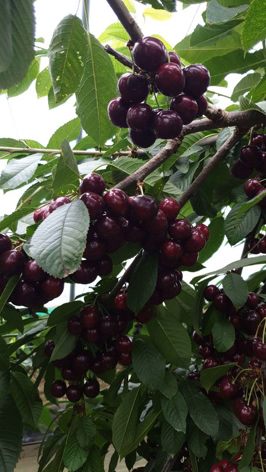
Click on McIntyre Fruit Ltd to learn more about Cherry growing in Scotland.
Click on Lower Hope Cherries to learn more about Cherry growing inn West Midlands.
That is all for this week![]()
Take care
The English Apple Man